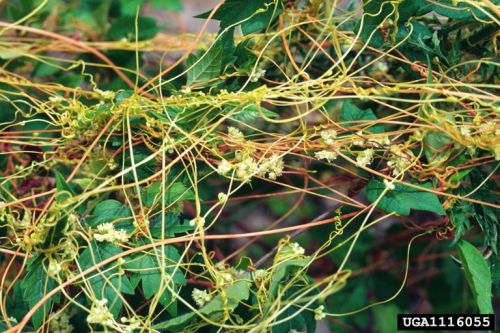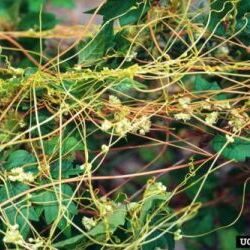
Priority: Strategic Control
General: Parasite that lives off of other plants, especially alfalfa, that has spaghetti like vines.
Height: Grows as high as a host plant.
Flowers: Flowers are small white or cream usually clustered.
Leaves/Stems: There are no leaves. Small scales may be present. The stems are thread-like. Their colour can range from orange to yellow to a pink colour. They stick to the host plant by suckers that look like warts.
Root: Aerial roots and suckers. Very few underground roots present only until the stems contact the host plant.
Strangleweed
Other Dodder species are found in Canada both invasive and native.
Differences: Contact LRISS for assistance with identification.
Where did it come from? Eurasia.
Where does it grow here? Found in most agriculture regions of BC including our region. Found along roadsides and highways where alfalfa is present as a result of seeding.
Reproduction: By seed. It can produce over 16,000 seeds per plant. The seed can stay viable in the soil for up to 60 years.
When does it grow, flower & seed? Seeds germinate in the soil and make slender stems. The stems have a window of time to make contact with a host plant or the seedling will die. Once in contact with the host, it wraps around the plant and feeds off of it. Stems form dense mats, flowers and seeds.
Spreads By: Seeds fall to the ground and get moved by road grading, mowing and in crops like hay.
Plant Type: Annual Parasite
- Attacks and kills vegetables, forage crops and garden ornamentals.
- Parasitic dodder can carry diseases that will affect vegetables.
- Stems can get caught in agriculture harvesting equipment.
- Dodder can attack native plants and shrubs.
- Contaminate hay crops. Do not buy or sell infested hay.
- Review your property regularly for this species.
- Treatment Remove small patches before it flowers & sets seed. The removal of a host and the stems before they set seed is very important. Burning has been reported to be effective.
- Cover bare patches or disturbed soil by planting or seeding with non-invasives.
- Check areas where you have removed invasives for any new plants that year and in future growing seasons.
- Dispose of invasive plants responsibly. Bag them for disposal at the local landfill. Composting and burning are not recommended.
- Contact LRISS for specific treatment recommendations.
